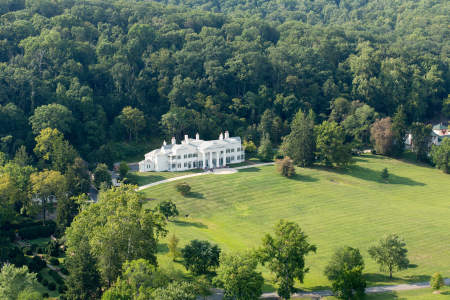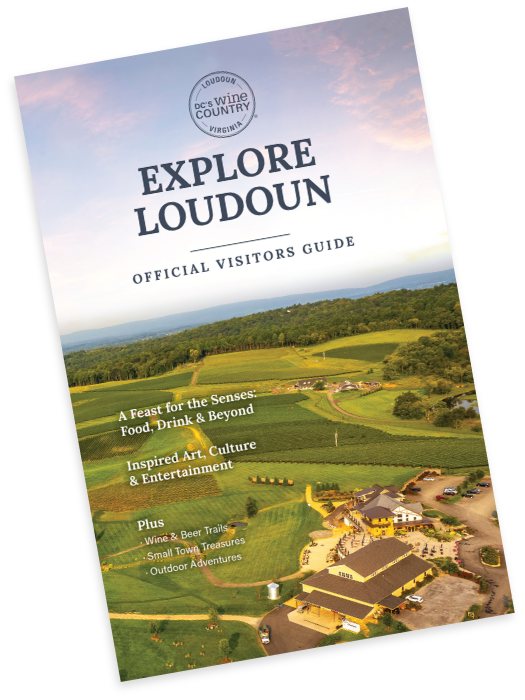Visitor Information Center
112 South Street SE, Suite 200
Leesburg, VA 20175
800-752-6118 | 703-771-2170
History of Loudoun County
Part 1: 1600-1800
1600s
The land that will become Loudoun is uncharted wilderness inhabited by Sioux (Manahoac), Algonquin, Iroquois and Piscataway Indians.
They farm, hunt and fish, and occasionally trade with white trappers and daring adventurers who make it up the Potomac to Point of Rocks. Potomac means “great trading place.”
1649
King Charles II of England grants five million acres of the “Northern Neck Proprietary” – land between the Rappahannock and Potomac, which includes Loudoun – to seven English noblemen.
1719
Scottish peer Lord Thomas Fairfax inherits the Northern Neck – some 5,282,000 acres.
Robert “King” Carter serves as Fairfax’s land agent before Fairfax sends his cousin William Fairfax down from Massachusetts to manage his properties. In 1747 Fairfax himself moves to Virginia from England, becoming the only resident peer in the Thirteen Colonies.
1722
Virginia Lt. Gov Spotswood signs a treaty with the Iroquois establishing the Blue Ridge Mountains as a buffer between Indian territory out west, and white settlements in the east. Today’s Loudoun is first part of Westmorland, then Stafford, then Prince William and then Fairfax counties.
1723
Granted land by Lord Fairfax, European settlers start to pour into the future Loudoun: slave-owning aristocrats of English ancestry to huge tracts of land in the east, south and west; Quakers and German American farmers from Maryland and Pennsylvania to the north, near the Potomac.
1728
Settler Joseph Chinn turns his rustic fieldstone home on an old Indian trail (today’s Route 50) into an “ordinary” – a tavern for travelers.
Chinn’s Ordinary will later become The Red Fox Inn, still in operation today. The village that springs up around it - Chinn’s Crossing – will become Middleburg, named since it was midway between Alexandria and the farmlands of the Shenandoah Valley. In 1748 Chinn’s cousin, a young surveyor for Lord Fairfax named George Washington, will visit.
Learn More
1732
German Americans – Pennsylvania Dutch – from PA and Maryland establish “The German Settlement” south of the Potomac, farming the rich topsoil and building log cabins.
The town later becomes Lovettsville.
Learn More
1733
Pennsylvania Quaker Amos Janney is granted 400 acres by Fairfax on the banks of Catoctin Creek, where he builds a house and a mill. Other Quakers follow.
The village – Janney’s Mill – will become known as Waterford.
Learn More
1740
Waterford and Pennsylvania Quakers establish the town of Goose Creek – today’s Lincoln.
As Quaker villages, Lincoln and Waterford become prominent in the struggle for the abolition of slavery.
Learn More
1755
George Washington, serving as a scout, is part of the 2,100 British and American troops who travel west through Loudoun, along Vestal’s Gap Road (loosely todays’ Route 7) to engage the French at Fort Duquesne, PA during the French and Indian War.
They pass through Leesburg. The mission is a disaster: ambushed by the French east of Pittsburgh; 700 troops are killed and Washington is wounded.
1757
The settlers ask Virginia’s government to create a new county for them. They name it Loudoun, for the commander of British forces in North America, Scotsman John Campbell, fourth Earl of Loudoun. Campbell himself never sets foot in Loudoun.
1758
County seat Leesburg is established at the crossroads of two Indian trails, the Old Carolina Rd (Route 15) and Vestal’s Gap (Route 7), and a courthouse is built.
Originally named George Town, it is renamed Leesburg either for two of its first trustees, brothers Francis Lightfoot Lee and Philip Ludwell Lee, or for their father, Thomas.
Learn More
Load More
The Founding and Revolution: 1775-1783
1775
While there are no battles fought in Loudoun, the county will contribute more soldiers to the war for independence from Britain than any other in Virginia.
1776
Francis Lightfoot Lee of Leesburg is a signatory to the Declaration of Independence in Philadelphia, a copy of which is read on the steps of Loudoun County Courthouse to cheering crowds.
1777
George Washington is now a General and Commander of the Continental Forces. Some 2,000 Loudoun men will join him at Valley Forge for the brutal winter of 1777-1778 as he rallies US troops.
1780
Loudoun native John Champe of Aldie is charged by Washington with infiltrating enemy lines and capturing the turncoat Benedict Arnold. He almost succeeds.
1782
A rope and pole ferry begins operations just north of Leesburg, allowing horses and wagons to cross the Potomac between Maryland and Virginia.
Still in operation today, White’s Ferry is the last working ferry on the Potomac.
1787
Loudoun native and Revolutionary War veteran Colonel Leven Powell establishes the town of Middleburg around the Red Fox Inn.
The inn is still in operation today.
Learn More
1798-1803
Oatlands plantation is established by George Carter south of Leesburg.
Carter is a great grandson of Robert “King” Carter, the property agent who oversaw land deals in Virginia for Lord Fairfax.
Learn More
Load More
Part 2: 1800-1900
1800
Loudoun’s population is 20,523 including 333 freedmen and 6,078 enslaved persons.
1814
When the British burn the White House in The War of 1812 the Declaration of Independence and the US Constitution are smuggled out by horse to a property outside Leesburg. This leads to the claim that Leesburg was, briefly, the capital of the U.S.
1820s
Black children living on Quaker farms in Lincoln attend school with whites at the Goose Creek Friends Schoolhouse – the first instance of school desegregation in Loudoun.
1823
The town of Snickersville is established on the slopes of the Blue Ridge.
This will later become the town of Bluemont.
Learn More
1823
James Monroe, the fifth President, founds Oak Hill estate, south of Leesburg, where he will later draft the Monroe Doctrine. Two subsequent presidents, James Buchanan (Sterling) and John F Kennedy (Middleburg) will go on to have Loudoun addresses.
1824
The town of Lincoln hosts the first statewide convention for the abolition of slavery.
1825
America’s favorite fighting Frenchman, Revolutionary War hero Marquis de la Fayette, visits Leesburg on a national tour from France. Between 8,000 and 10,000 people turn out at the Courthouse in Leesburg to pay tribute to the aging French General. The event was catered by the Peers Hotel (later the Laurel Brigade Inn) opposite today’s Tally Ho.
1825-1860
Loudoun’s Golden Age: The soil is rich and fertile, farms prosper, property prices soar, roads and canals are built, and towns and villages spring up with taverns, inns, mills, blacksmiths, gunsmiths, grocers and banks.
Towns and villages created include Purcellville, Hillsboro, Hamilton, Unison and Aldie Mill.
Learn More
1853
Colonel Richard H. Dulany of Welbourne founds the Upperville Colt & Horse Show,
now the oldest (and arguably most prestigious) horse show in the U.S.
Learn More
1859
Militia units cross Loudoun to put down an insurrection: John Brown’s Raid at Harpers Ferry.
Load More
The Civil War (1861-1865)
1861
Both Loudoun delegates to the Secession Convention vote against seceding from the Union, but in May, Loudoun votes in favor – 1,626 to 726. The dissenting minority are mostly Quakers and Germans from Lovettsville and Waterford. In June, the Loudoun militia is called up for Confederate service.
1861
Confederate victory on October 21st at the Battle of Ball’s Bluff on banks above the Potomac on the outskirts of Leesburg.
36 Confederate and 223 Union soldiers are killed, including Col. Edward Baker, a sitting U.S. Senator, still the only sitting Senator to be killed in military engagement. Bodies of drowned Union soldiers float down river to Washington DC, shocking residents. Today the Leesburg site, east of Battlefield Parkway, is a National Historic Landmark and cemetery.
Learn More
1862
Citizens of Waterford establish the Independent Loudoun Rangers cavalry unit,
the only unit from the South to fight with the Union.
Learn More
1862
At the same time, Lt. Col John Singleton Mosby – The Grey Ghost – organizes his own Rangers, a hand-picked band of men dedicated to guerrilla operations against Union troops and supply lines.
Mosby’s raiders are a constant thorn in the side of Union troops.
Learn More
1864
To drive out Mosby, on August 16th Union cavalry under General Sheridan get orders to torch the Loudoun Valley. The Burning Raid lasts five days, destroying farms, barns, livestock and forests.
1865
Unaware Robert E. Lee has surrendered at Appomattox, Mosby defeats the Loudoun Rangers at Halltown, West Virginia. Ten weeks later he surrenders, the last Confederate officer to do so.
1865
Slaves are freed. Loudoun is occupied by the victorious Northern army.
1870
Virginia is readmitted to the Union. The first census after the war shows a population of 20,929, including 5,691 African Americans.
1871
The first business, Joseph Arundel's store, opens in Ashburn.
This area was originally Farmville.
Learn More
1875
The Washington & Ohio Railroad reaches Round Hill.
This will later be the Washington & Old Dominion Railroad.
Learn More
1879
African American leader Frederick Douglass – social reformer, abolitionist, orator, writer and statesman – speaks in Purcellville to a crowd of 2,000.
Load More
Part 3: 1900-1999
1900
The W & OD reaches Bluemont. The village becomes a swanky hill country resort for Washington DC’s smart set, and the Blue Ridge Inn, built in 1893, is the place to stay.
1903
1,000-acre Morven Park and its colonnaded Greek Revival-style mansion in Leesburg becomes home to wealthy lawyer, horseman and future Virginia Governor, Westmoreland Davis.
Elected in 1917, Davis leads Virginia in the final year of World War One. He lives until 1942 and is buried on the property.
Learn More
1905
The Great Hound Match to determine the best breed of foxhound – English or Southern-bred American dogs – takes place around Middleburg. Wealthy New York huntsmen come down to take part, and newspapers from New York, Boston and London report on it.
Wealthy Northerners begin to hear about the beautiful countryside and start buying up derelict estates, fixing grand homes and preserving the land for equestrian pursuits. Thus, Loudoun is reborn as Hunt Country. If the Civil War devastated the county, the “Second Northern Invasion”, as it became known, helped save it.
Learn More
1917-1918
30 Men from Loudoun lose their lives in World War I.
1929
A plaque is laid in Hillsboro for one Susan Catherine Koerner Wright, born in Hillsboro in April 1830 and the daughter of a prominent local wagon maker. Her two sons, Wilbur and Orville, inheriting the mechanical genes from their mother’s family, would go on to invent motor-powered flight.
1931
Tally Ho theater opens in Leesburg.
Its first screening was “Sporting Blood” starring Clark Gable.
Learn More
1933
Charles Hamilton Houston becomes the first African American attorney to argue a major case in a Southern courtroom (Leesburg); his successful strategy later earning him the sobriquet: “The man who killed Jim Crow.”
1941
General George C. Marshall, Chief of Staff of the U.S. Army, and wife Katharine, become Loudoun residents.
They buy Dodona Manor in downtown Leesburg.
Learn More
1941-1945
68 Loudoun men and women lose their lives in World War II.
1944
Waterford preservationists prevent the town mill from being torn down, establishing the Waterford Fair.
One of the most unique cultural events in the U.S., it is still going strong today.
Learn More
1947
George C. Marshall, now Secretary of State, unveils the Marshall Plan (drafted in Dodona Manor) to rebuild Europe and is named Time’s Man of the Year.
President Truman visits with him at Dodona in 1950. In 1953 he wins the Nobel Peace Prize.
Learn More
1954
The National Sporting Library & Museum is established in Middleburg.
The inviting, 6-acre campus, world-class research Library, and fine art Museum highlight the rich heritage and tradition of country pursuits.
Learn More
1958
Construction of Dulles International Airport begins on 12,500 acres in southeast Loudoun, spurring growth and the development of Sterling.
President Eisenhower attends the opening.
Learn More
1960-1963
Seeking respite from the White House, the Kennedys rent a home on an estate outside Middleburg.
Jackie joins the Orange County hunt north of town, lunches at the Red Fox Inn, and by 1963 is building Wexford, a five-room country house on 160 acres.
Learn More
1962
The creation of planned community Sterling Park – today’s Sterling – around Dulles Airport begins the suburban expansion of Loudoun.
Fast forward 60 years and Sterling – also sometimes referred to as Dulles – is a bustling area, famous for its high-tech data centers, modern shopping malls and suburban residential communities.
Learn More
1963
On October 27th, JFK and Jackie are photographed leaving St. Stephen the Martyr Catholic Church in Middleburg with daughter Caroline and son John Jr. It is the last weekend the family will spend together in Loudoun. JFK is assassinated in Dallas three weeks later.
1966
Gifted to the National Trust for Historic Preservation by the Eustis family, Oatlands Historic House & Gardens, opens to the public.
1967
Morven Park – the 1,000-acre “Central Park of Loudoun” – opens to the public.
1968
The W & OD ceases operations.
It later becomes the W&OD Trail foot and cycle path.
Learn More
1968-1990
Proximity to Washington, DC and the Defense Department give Loudoun and other Northern Virginia-based contractors the inside lane in developing the server farms, data centers and fiber optic cable that will become the infrastructure of the Internet. Little does the world know, but Loudoun will soon become the hub through which most of the planet’s Internet traffic will flow.
1970
The population of Loudoun is 37,150.
1976
Hollywood star Elizabeth Taylor marries Virginia Senator John Warner on his 2,700-acre cattle and horse farm, Atoka, outside Middleburg. Taylor lives on and off near Middleburg for the next six years before their divorce in 1982.
1979
The first Christmas in Middleburg parade attracts a handful of locals.
Forty years later it’s one of the most beloved holiday traditions in the country, drawing upwards of 17,500 visitors each year.
Learn More
1984
Dulles Toll Road opens, easing the DC commute and bringing more residents to Loudoun.
1984
Willowcroft, Loudoun’s first winery, opens south of Leesburg.
Thirty-five years later there will be more than 40 wineries and tasting rooms in Loudoun, and the county will be known as DC’s Wine Country.
Learn More
1985
Plans for development of Ashburn Farm are unveiled, the beginning of today’s Ashburn.
1989
Old Dominion Brewing Company in Ashburn is the first craft brewery to open in Loudoun.
By 2020 there will be more than 35 breweries in the county linked by the regionally renowned LoCo Ale Trail.
Learn More
1991
Luxury Landsdowne Resort & Spa opens on 476 acres on the banks of the Potomac.
1992
Server farm MAE-East is established in Ashburn, allowing the world’s fledgling online companies to connect.
Ashburn becomes the hub of the world’s Internet traffic.
Learn More
1995
Dulles Greenway toll road opens.
1995
The 1,800 sq-mile Mosby Heritage Area is created to preserve the rural historic landscapes of Loudoun, Fauquier, Prince William, Clarke and Warren counties.
1996
AOL (America Online) moves its HQ to Loudoun, to be close to MAE-East, spurring development of a wave of data centers in Ashburn and Sterling. The area will become known as Data Center Alley.
1999
A Holstein-Friesian bull named Round Oak Rag Apple Elevation, born in Philomont in 1965, is named Bull of the Century. Hailed as “the most influential animal in history”, close to 90 percent of all Holstein cattle in the world – some eight million livestock – have the sturdy bull’s genes.
Load More
Part 4: 2000-Present Day
2002
Acting legend and Virginia resident Robert Duvall attends the gala opening and private screening of his movie, “A Shot at Glory” at the Tally Ho theater, downtown Leesburg.
2003
National Parks name Loudoun County Courthouse a National Underground Railroad Network to Freedom site.
The Thomas Balch Library and Oatlands Historic House & Gardens are soon also listed.
Learn More
2009
Catoctin Creek Distillery opens in Purcellville, the first distillery in Loudoun since Prohibition.
2011
Sterling-based rocket engineers Orbital (now Northrop Grumman) successfully petition Loudoun supervisors to rename the street their offices are on to Warp Drive – the name given to the technology that allows ships in the Star Trek universe to travel faster than light.
2013
The Salamander Resort & Spa opens in Middleburg, vision of billionaire entrepreneur Sheila Johnson. The Middleburg Film Festival debuts the same year and is soon regarded as a major stop on the Oscar trail.
Sightings of stars such as Meg Ryan, Gal Gadot and Emma Stone become commonplace.
Learn More
2014
Physicist Robert Eric Betzig, a Senior Fellow at the Janelia Farm Research Campus in Ashburn, wins the Nobel Prize in Chemistry for “the development of super-resolved fluorescence microscopy.”
2015
The National Sporting Library & Museum in Middleburg installs a statue of Paul Mellon’s 1993 Kentucky Derby winning horse Sea Hero.
2016
A bottle of Blanc de Blancs from Middleburg-based Greenhill Vineyards is included in Academy Awards gift bags to select nominees.
2017
The 70th Anniversary of the Marshall Plan is celebrated at George C. Marshall’s Dodona Manor, with European dignitaries and former Secretary of State Madeline Albright in attendance.
2019
Ice skating arena ION International Training Center and soccer stadium Segra Field, DC United’s training facility, open in Leesburg.
These establish Loudoun as a sports destination.
Learn More
2019
Amazon announces plans to open its HQ2 in Arlington, but the online giant already operates 25 of the more than 70 data centers that cover 10 million square feet of Ashburn and Data Center Alley. An estimated 70 percent of the world’s Internet traffic now passes through Loudoun.
2020
Loudoun’s population hits 400,000 – more than 100 times what it was in 1970. The county is frequently ranked as the wealthiest in the U.S., and one of the best in which to live and raise a family.
Load More
SOURCES & ACKNOWLEDGMENTS
Eugene Scheel - Cartographer, Writer and Historian
Laura Christiansen - Curator of Manuscripts and Archives, Thomas Balch Library




